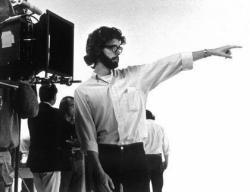A long time ago, in a galaxy that had never seen Star Wars, George Lucas was an art-house filmmaker. Now, through the wonders of cyberspace, you can watch most of his early shorts online.
After one of Robert Altman’s earliest shorts was unearthed last week, I thought of 6-18-67, one of the infamous first films of a then 23-year-old George Lucas. Before I found it online, 6-18-67 had always seemed more mythical to me than real: It’s story is told to epitomize the pre-Star Wars (and pre-American Graffiti) George Lucas. When Lucas told Slate columnist Bryan Curtis that he would return to making personal movies, Curtis described the film: “They’ll be like the experimental movies Lucas made in the 1960s, around the time he was at U.S.C. film school, when he recorded clouds moving over the desert.”
Lucas shot 6-18-67 on a scholarship from Columbia Pictures. He was supposed to produce a short making-of documentary about MacKenna’s Gold, which was filming in Arizona. However, he felt alienated from the Hollywood production, and instead made a lyrical short about man and nature in the desert. In Easy Riders, Raging Bulls author Peter Biskind elaborates on how this choice embodied Lucas’s “anti-studio attitude”:
[MacKenna’s Gold] was a lumbering, elephantine studio Western, very much in the style of the bloated musicals of the ‘60s, and it was Lucas’s introduction to the Old Hollywood. “We had never been around such opulence, zillions of dollars being spent every five minutes on this huge, unwieldy thing,” he said. “It was mind-boggling to us because we had been making films for $300, and seeing this incredible waste—that was the worst of Hollywood.” While the other students shot conventional “making-of” documentaries, Lucas shot an imagistic film about the beauty of the desert, with the production barely visible in the far distance.
In other words, 6-18-67 is about as far as you can get from The Phantom Menace 3D. In fact, the short looks more like a Terrence Malick movie than a Lucas blockbuster. When he zooms in on a bird, and then a squirrel, the sequence could be straight out of Badlands. Similarly, when those images of nature are juxtaposed with the hum of electricity and then whirring windmills, it’s less Attack of the Clones than Koyaanisqatsi. At one point a car whips by, and Lucas racks focus onto a flower.
You can find most of Lucas’s early films are available online, if you do a little digging. Look at Life (1965) is his first credited film on the IMDb—he made it for an animation course at U.S.C. The collage of stills expresses a sort of hippie consciousness, depicting a battle between the powers of love and oppression.
1:42.08 (1966) is a sort of tone poem about the beauty of fast cars. He would later return to the subject in American Graffiti and in various forms throughout his career (the titular finishing time is in minutes and seconds, not parsecs).
Freiheit (1966), is another film about man versus an oppressive establishment. (Freiheit is the German word for freedom.) The star, Lucas’s schoolmate Randal Kleiser, went on to direct movies like Grease and The Blue Lagoon.
Electronic Labyrinth: THX 1138 4EB (1967) is Lucas’s most famous short. The 15 minute sci-fi film, made at the University of Southern California, took first prize at the National Student Film Festival in 1968, and would form the basis for Lucas’s astonishing debut feature THX 1138 (1971). Like Freiheit, it depicts a man attempting an escape from an oppressive society, but this time it takes place in a dystopian future. While it’s much darker and more distant than the blockbuster that made Lucas’s name, it’s the short that most resembles Star Wars, managing to create a whole futuristic world on a student’s shoestring budget.
Filmmaker: A Diary by George Lucas (1968) is another making-of documentary, filmed during the production of Francis Ford Coppola’s The Rain People. Lucas was Coppola’s Padawan learner, and he often films Coppola from below, making him loom large in the frame. And he looks happy to be on a film set, rather than, as in 6-18-67, trying to get as far as possible from it. At one point Coppola describes his own deliberations about whether to take paycheck jobs: “The world is filled with guys who said ‘Well, I’m going to make the money and then I’m going to make the personal films.’ And somehow, they never get around to doing it.”
Previously:
Is This Robert Altman’s First Film?
Did You See This? The Internet Swedes Star Wars
Name That Thistle: Terrence Malick Cutaway or Nature Documentary?
